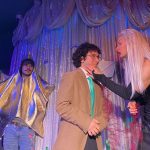By Ashleigh Adams
The character of the witch has been a mainstay in literature for centuries, with depictions ranging from menacing to aspirational. In modern media there is a wide variety of witchy stories; traditional portrayals present a sort of transgressive femininity, showcasing women who are old, vain, and power-hungry. Spectators have long enjoyed the witch as the ultimate horror, the abject woman. Old, ugly and threatening female characters subvert the idea of how a woman ÔÇ£shouldÔÇØ be – young, beautiful, and submissive. With the growing feminist movement and changing societal discourses, there has recently been a shift in literature from the villainised woman, crafted for male audiences, to depictions of the witch that caters to a more feminine spectator.
A Goddess, or a Gruesome Witch?
One of the earliest depictions of witchcraft can be found in ancient Greek religion and mythology. Hecate was a goddess of witchcraft who is said to have had the ability to use her power for both good and bad; she was seen as a fair goddess to her worshippers and a multi-dimensional entity. However, Hecate is said to have been the mother of the enchantress Circe. In HomerÔÇÖs Odyssey (1614), Circe is said to have used her beauty to lure men to her island Aeaea where she would turn them into animals. The earliest depictions of witchcraft reflect societyÔÇÖs distrust of beautiful women and the idea that women are hysterical beings, unable to control their emotions. However, some modern adaptations give new life to past stories of the witch. In the novel Circe (2018) the titular character is depicted as a maternal figure with a sympathetic desire for love; as audiences have grown tired of witchy stereotypes, modern depictions have turned to humanity as a central characteristic of their witches.
The Desire for Youth
Youth has become synonymous with beauty, and a womanÔÇÖs looks is deemed by society to be her most valuable possession. Yet the quest for beauty is seen as frivolous and pathetic; society mocks women for caring about lip-gloss and manicures, whilst the same society profits from the female interest in aesthetics. The fear of vain women is central to most witchy literature. The earliest depiction of this kind of witch I can remember reading is in Snow White (1812). The Evil Queen uses magic in an attempt to destroy Snow White and beome the most beautiful woman of the time; a trope we have grown accustomed to in a society where women are often depicted as tearing other women down. This story, and others like it, seem to warn against vanity without unpacking why this quest for beauty exists in the first place; instead, these witches are usually portrayed as insane.
The Witch Stereotype
For much of history we have been governed by superstitions. Superstitions have historically held great power, and continue to do so today; for this reason, the witch has come to be perceived as a great threat. The hag stereotype is captured in no text better than Macbeth (1623). Macbeth was written by Shakespeare at a time when societyÔÇÖs belief in the witch was very real. Women were being punished and blamed for crimes under the accusation of witchcraft. The weird sisters in ShakespeareÔÇÖs tragedy are depicted as ÔÇÿwitheredÔÇÖ and ÔÇÿwildÔÇÖ hags who prey upon MacbethÔÇÖs ambition in order to make their twisted prophecy come true. They are seen as the harbingers of evil, and shoulder some of the responsibility for MacbethÔÇÖs crime. This type of witch is awfully familiar to most readers, and can be found in many of the stories of our childhood. The titular witches in Roald DahlÔÇÖs The Witches is the epitome of the old hag stereotype. Although one of my favourite childhood stories, the idea that a witch could be lurking under the skin of a woman is a less than flattering portrayal.
Where Are The Witches Now?
Over the years, the literary witch has come full-circle, from the multi-dimensional goddess to the one-dimensional hag, and then back to a more multi-dimensional bringer of good or evil. The Harry Potter series had most of us wanting to be witches or wizards at the time of its release, a societal motif that persists today. Hermoine Granger was my idol growing up; she is portrayed as smart, brave, and determined. Her portrayal was one of the first times I had ever read a witch depicted this way.The overall image of the witch has been rehabilitated; the witches in my childhood morphed from beings that I feared as a child, into people I hoped to be. Whether that be because of Hermoine Granger or Stevie Nicks; I think a lot of us have been tempted to join a coven over the years




